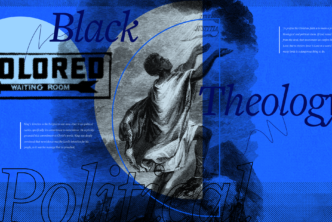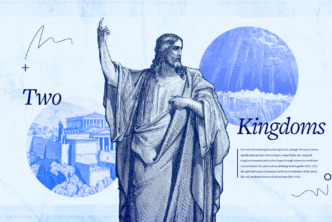“Take now your son, your only son whom you love, Isaac, and go to the land of Moriah, and offer him there as a burnt offering” (Gen 22:2). Chilling words. Abraham, however, does not ask questions. He doesn’t need a clarification; he makes no excuses, causes no delays. He understands the significance of the command.
So he rises early in the morning and saddles his donkey—to make the most sacrificial of burnt offerings.
In this act, Abraham becomes an example for Old Covenant believers to follow.
Understanding the history, practice, and significance of the burnt offering will also help New Testament believers understand the sacrifice of Abraham and apply his example to their own Christian walks.
The history of the burnt offering
Without any explanation or instruction we know about, people after Eden included sacrificial offerings in their worship. The first Old Testament story after Adam and Eve’s expulsion tells the story of Cain and Abel’s offerings to the Lord. A few chapters later, Noah departs from the ark, builds an altar, and offers his own sacrifices: the first recorded burnt offerings (Gen 8:20).
This is a practice which, by this time in the Old Testament story, seems already well established. Abel’s offering, while not a burnt offering, establishes the proper prioritization for an offering and reflects the proper heart of worship (Gen 4:4). The “choice parts” of the animal are offered to God by fire (Lev 3:16).1 The worshipper can consume some of the animal, but the best cuts are devoted to the Lord by fire.2
The burnt offering was a completely consumed offering, one that left nothing but ashes. It is sometimes called the “holocaust sacrifice” because everything goes up in smoke (holo, “whole”; caust, “burnt”).
In Genesis, Abraham travels through Canaan building altars and presumably sacrificing upon them (Gen 12:7–8; 13:18), following the customs of those who had gone before him.
The practice of the burnt offering
The book of Leviticus describes the process of completing a burnt offering. It details the worshipper’s responsibilities (Lev 1:3–17) and the priest’s responsibilities (Lev 6:8–13). The worshipper freely brings an unblemished male animal to the tabernacle. He presses his hand on the animal’s head and prays a prayer of confession (cf. Lev 16:21).3 He then kills the animal and captures the blood in a vessel, which the priest then sprinkles around the altar. The worshipper then skins the animal and cuts it into pieces. Then the priest takes the pieces of the animal and places them on the wood, where it is burned completely.
The peace offering, by contrast, burns only the fatty parts of the animal (the best parts), leaving the other sections for the priest and worshipper to eat (Lev 7:11–38).
The burnt offering is a very diverse offering, and some of the details differ depending on the animal sacrificed or the specific kind of sacrifice—sin offering (Lev 4:1–12) or daily sacrifice (Num 28:3–8). But the general idea of the burnt offering remains the same throughout the Old Testament: the entire sacrifice was consumed.
The significance of the burnt offering
The burnt offering was one of the most frequent and significant offerings a worshipper could offer in Old Testament times.4 But because the ancient world was already very familiar with this offering, modern readers are left to discern its purpose and significance from only scant biblical data.
This much we can discern, however; the burnt offering had multiple purposes:5
1. The worshipper sought the favor of the Lord
Whether it was to atone for sin (Lev 1:3–4) or gain a blessing (1 Kgs 3:4–15), the worshipper sacrificed something valuable to the Lord.
2. The burnt offering represented a gift to God
The worshipper incinerated something valuable, communicating to the Lord, This valuable thing I possess belongs to you. The animal sacrificed had to be a valuable animal, not one that was about to die. Leviticus 1:3 explicitly stipulated an unblemished one-year-old male. David correctly refused to offer burnt offerings which did not cost him anything (2 Sam 24:24), and Malachi rebuked Israel for offering blind and lame animals on the Lord’s altar (Mal 1:7–8). The Lord only bestowed his favor upon the worshipper who offered the Lord a costly sacrifice.
3. The burnt offering was a substitutionary sacrifice
The sinfulness of man merited the wrath of God, a wrath which was placated by sacrifices. The wickedness of Noah’s generation angered the Lord, meriting the righteous judgment of God. When Noah disembarked from the ark, he offered burnt offerings which were “a soothing aroma” to the Lord. Similarly, in Leviticus, the worshipper offered burnt offerings as “a soothing aroma” to atone for his sin and placate the wrath of God (Lev 1:9, 13, 17). By laying one’s hand on the head of the animal (Lev 1:4), the worshipper acknowledged that the animal’s death atoned for his sin, “and it will be accepted on his behalf to make atonement for him.”6
The burnt offering was the most common and versatile sacrifice. Not every burnt offering included all three of these purposes. For example, God’s command to offer Isaac, Abraham’s most precious possession, as a burnt offering lacks a substitutionary component. Conversely, the ram which was substituted for Isaac cost Abraham nothing. Abraham’s act, however, merited him the favor of the Lord (Gen 22:15–18).
The belief in the burnt offering
The most important component of the burnt offering was the belief of the worshipper. Repeatedly, Leviticus states that worshippers must follow God’s explicit directions and offer their best to the Lord (Lev 6:22–27) of their own free will (Lev 1:3; 19:5; 22:19, 29). The burnt offering required the worshipper to incinerate a valuable asset which could have been used to increase one’s wealth. The worshipper would have to believe that the Lord would provide for their needs regardless of the loss.
The temptation to offer a less valuable asset—or not to sacrifice at all—was significant. Even more appealing, however, was to find a way to look “spiritual” and offer the burnt offering while still increasing one’s wealth—perhaps by taking advantage of someone less fortunate in society. Israel and Judah were regularly condemned by the prophets for these very sins. Isaiah condemned Judah when he said,
“What to me is the multitude of your sacrifices?,” says the Lord; I have had enough of burnt offerings of rams and the fat of well-fed beasts; I do not delight in the blood of bulls, or of lambs, or of goats. (Isa 1:11 ESV)
Of course, the Lord had commanded them to sacrifice. The people of Judah went through the external motions of belief but lived lives of unbelief. Their wicked deeds evidenced a lack of faith in the Lord to provide (Isa 1:16–17). Therefore, the Lord judged them:
When you spread out your hands, I will hide my eyes from you; even though you make many prayers, I will not listen; your hands are full of blood. (Isa 1:15 ESV)
Because Judah sought to provide for themselves, the Lord would not provide for them.
Abraham, by contrast, exemplified belief by trusting in the Lord to provide. How could the Lord fulfill his promise and establish his covenant with Isaac (Gen 17:21) if he became a burnt offering? Abraham did not know how, but he believed that the Lord would provide (cf. Heb 10:17–19). To remind all who follow that the Lord does provide, he named the place, “The-Lord-Will-Provide.”
The burnt offering principle in the New Testament
The New Testament teaching concerning the sacrificial system corresponds with the Old Testament’s. Just like in the Old Testament, God desired humility and obedience more than sacrifice (1 Sam 15:22–23; Ps 40:6–8). The author of Hebrews correctly explained that the Old Testament’s sacrificial system reminded the Old Testament saints of their sins. The blood of bulls and goats could not actually take away sin; instead, the saint is sanctified by the once-for-all sacrifice of Jesus the Messiah (Heb 10:1–10).
The purpose of the sacrificial system, however, continues to apply to the New Testament saint. The author of Hebrews teaches, “But do not forget to do good and to share, for with such sacrifices God is well pleased” (Heb 13:16). Offering a burnt offering was a sacrificial act; it cost the worshipper something. In the same way, the New Testament believer should live a life of sacrifice, giving not only of one’s abundance, but even in one’s poverty to those less fortunate than oneself.
James also applied this principle of sacrifice and generosity to the New Testament church and used Abraham as an example. Just like ancient Judah, the church went through the external motions of belief but lived lives of unbelief:
If a brother or sister is poorly clothed and lacking in daily food, and one of you says to them, “Go in peace, be warmed and filled,” without giving them the things needed for the body, what good is that? (Jas 2:15–16 ESV)
By refusing to sacrificially attend to the needs of a brother or sister, the presumed believer was declaring, “I refuse to obey God because I don’t believe he will provide.” James reminds the church of Abraham’s example, who not only said that he believed, but he also lived belief by obeying the Lord and trusting in him to provide.
Related articles
- What Makes Christian Ethics Truly “Christian”? A Seminary Prof Answers
- Is Money the Root of All Evil? What the Bible (Really) Says
- Delight Yourself in the Lord: What the Bible Teaches + 7 Tips
- Sermon on the Plain: What It Is & How It Differs from the Sermon on the Mount
- Gordon Wenham, Genesis 1–15, Word Biblical Commentary (Waco, TX: Word Books, 1987), 103.
- John Goldingay, Genesis, Baker Commentary on the Old Testament: Pentateuch (Grand Rapids, MI: Baker Academic, 2020), 96.
- The prayer is inferred from Leviticus 16:21. See Gordon J. Wenham, The Book of Leviticus, New International Commentary on the Old Testament (Grand Rapids, MI: Eerdmans, 1979), 61.
- Allen P. Ross, Holiness to the Lord: A Guide to the Exposition of the Book of Leviticus (Grand Rapids, MI: Baker Academic, 2002), 85.
- Adapted from Ross, Holiness to the Lord, 29–30; Wenham, Book of Leviticus, 55–63.
- Wenham explains, “The burnt offering does not remove sin or change man’s sinful nature, but it makes fellowship between sinful man and a holy God possible. It propitiates God’s wrath against sin,” Wenham, Genesis 1–15, 57.







